Tips on submitting insects for identification
No more guessing: Here’s how to package up insects and other arthropods for identification from the lab.
People have sent me insect specimens in all manner of bottles, boxes and other types of containers. Some of the more creative and intricate containers appeared to have been specially engineered and constructed by the submitter for this single purpose. A few years back a person sent me a pine sawyer beetle in an elaborate casket made from a small candy tin. It was obvious to me the dead beetle had been prepared for shipping with great respect and reverence. I certainly appreciated the effort and care the submitter had taken, but I couldn’t help but think, “All this for a dead bug!”
Mailing a specimen
Here are some basic considerations for submitting arthropod specimens to MSU Plant and Pest Diagnostics for identification. Not surprisingly, complete, intact and well-preserved specimens offer the best chance for identification. Peeling a squashed bug from a flyswatter or from the bottom of your shoe, putting it in an envelope and mailing it to me is not a recommended method. Dried and unprotected insects are easily crumbled during mail processing. The smaller the bug fragments, the more difficult it is to identify what the fragments once were. Bug dust is pretty much impossible to identify. Attaching the specimens to scotch tape is also not recommended, in fact, this is one of my pet peeves, especially if the specimen is folded into the sticky side of the tape. This almost guarantees that I will destroy the bug when I attempt to remove it from this sticky mess.
For most types of insects and other arthropods, killing and shipping the specimens in a small, leak proof vial filled with rubbing alcohol or white vinegar is usually the best method. Not only does the alcohol or vinegar preserve and protect the specimen, it also kills the specimen. Recently a client sent me three live spiders in a single container. When I opened the container I found one live and well fed spider and a small pile of spider remains. The surviving spider had made a tasty meal out of her traveling companions which rendered them pretty much unidentifiable.
Submitting moths and butterflies are the exceptions because their wing patterns are important characters for identifying them. These should be shipped in a small box that is lined with tissue paper to keep the specimen from banging around inside the box. Live insect larvae should be lightly boiled first before going into the alcohol to keep them from shriveling and turning black.
Mail specimens to:
MSU Plant and Pest Diagnostics
101 Integrated Plant Systems
East Lansing, MI 48824-1311
Be sure to include a note with your contact information including your email address.
Sending digital photos
More and more people are emailing me digital photographs of their bugs for identification. Some photographs are better than others. If you are thinking about emailing me insect photos, please keep in mind that good quality photos offer the best chance for identification. Photos should be taken in good light and photos should be in focus. If you look at the photos on your computer and they appear dark and blurry, then they will undoubtedly appear dark and blurry to me when I look at them on my computer. Send your photos to msubughelp@msu.edu.
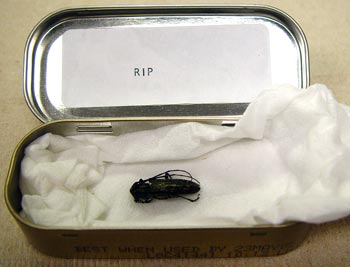
Elaborate specimen caskets are normally not required for sending specimens to the lab for identification. Note the “RIP” sign on the lid of the casket. Photo credit: Howard Russell, MSU Diagnostic Services.
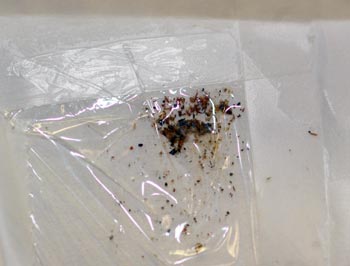
Insects are normally reduced to a fine powder when simply place in an envelope and mailed to me. All the king’s horses and all the king’s men will never put this buggy back together again. Photo credit: Jan Byrne, MSU Diagnostic Services.
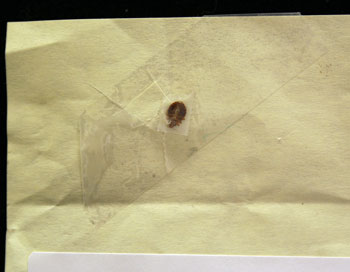
Sticking specimens onto Scotch tape is also not a recommended method of submitted specimens. All their parts come off during any attempt to free them from the tape. Photo credit: Jan Byrne, MSU Diagnostic Services.
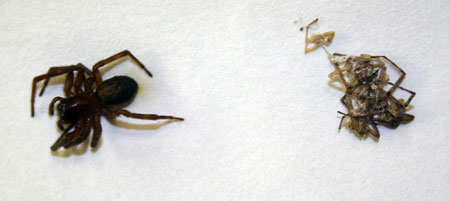
This photo shows the result when two or more live spiders are sent in for identification. Here the lone survivor is shown with the remains of her two traveling companions which she dined upon while enroute to the lab. Photo credit: Jan Byrne, MSU Diagnostic Services.
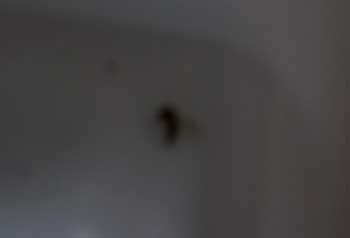
This photograph was sent to me a few years ago. When submitting photographs of insects keep in mind that I don’t have a computer program that fixes dark and blurry photos.



 Print
Print Email
Email


